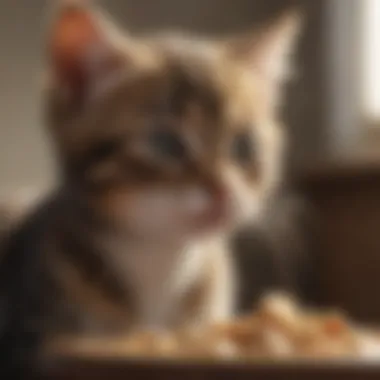Feeding Kittens: Essential Nutrition and Feeding Tips


Intro
Caring for a kitten is like embarking on a new adventure, one that comes steeped in joy and obligation. Kittens are wondrous little creatures, but they demand a keen understanding of their nutritional needs to thrive. As pet owners, it is crucial to grasp not merely what to feed them, but also how their feeding schedule influences their growth and overall health. A delicate balance exists between providing the right types of food and ensuring they eat at appropriate intervals.
This article delves into the intricacies of kitten nutrition and feeding frequency, serving as a compass to guide both new and seasoned pet owners. We navigate through the essential aspects, from the specific types of food that cater to a kitten's developmental stage to the importance of hydration, thereby equipping you with the knowledge necessary for nurturing these delightful furry companions effectively.
Pet Care Essentials
Ensuring your kitten receives appropriate daily nutrition is foundational to its health and well-being. Every bite counts, so understanding what goes into their meals becomes imperative.
Daily Nutrition Requirements
Kittens require a well-rounded diet that combines proteins, fats, and carbohydrates, mimicking what they might consume in the wild. The growth rates during their first year are staggering, and their diets must reflect their energetic lifestyles. Key points to remember include:
- High Protein: Essential for muscles and overall development. Look for chicken, turkey, or fish as primary ingredients.
- Healthy Fats: Provide energy and support brain development. Omega-3 and omega-6 fatty acids are beneficial.
- Hydration: Wet food is ideal because it adds moisture to their diet, which is often overlooked. Kittens should always have access to fresh water.
As a general rule, kittens older than four weeks can start transitioning from their mother’s milk to wet or dry food, gradually introducing solid meals into their diet until they are completely weaned.
Exercise and Playtime
A well-fed kitten isn't content just to lounge about; it needs stimulation. Engaging your kitten with regular play encourages healthy development and aids digestion. Toys like feathers on strings or small balls can keep them entertained and active. Not only does this promote physical health, but it also provides mental challenges that are crucial for their growth.
"A tired kitten is a well-behaved kitten."
Grooming Tips
Though they may not need as rigorous a schedule as adult cats, grooming should be an integral part of your kitten's routine. Regular brushing removes tangles and reduces shedding, which is important in establishing a bond. Moreover, it helps identify skin issues or parasites early, an added bonus for maintaining health.
Health and Wellness Check-ins
Regular vet visits are indispensable as your kitten grows. Vaccinations, deworming, and health check-ins create a safety net against potential health worries. Moreover, vets can guide you on any nutritional modifications that may be necessary as your kitten ages.
By establishing a sturdy foundation of care centered around nutrition and activity, you will pave the way for a happy and healthy kitten. This foundational knowledge enables pet owners to nurture their young cats in the best way possible.
Understanding Kitten Nutrition
When it comes to your kitten’s development, understanding nutrition is paramount. Just like a tiny seed that needs the right soil to sprout and grow strong, a kitten's growth hinges on what it consumes. Proper nutrition impacts everything from their energy levels to their overall health. Therefore, this article delves into the specifics of kitten nutrition to arm pet owners with the wisdom needed to foster healthy growth.
Essential Nutrients for Growth
Proteins
Proteins are the building blocks of life, acting as a crucial element in the development of a kitten's muscles, organs, and immune system. They help with tissue growth and repair, an essential aspect as your kitten's body is rapidly developing. The key feature of proteins lies in their ability to provide essential amino acids, which are not synthesized by the body and must come from food.
Kitten food should ideally contain a higher proportion of protein compared to adult cat diets. Fats and carbohydrates are also necessary, but without adequate protein, your kitten may not thrive. This emphasis on protein is vital in this article, as the various forms, such as chicken or fish, differ in quality and nutritional profile.
Fats
Fats often take a bad rap, yet they play a significant role in a kitten's diet. These nutrients furnish energy reserves, helping kittens maintain their high activity levels. The best fats for your fluffy friend are those that include omega fatty acids. These are essential for cognitive function and contribute to a shiny coat and healthy skin.
The unique aspect of fats is their calorie density—each gram provides more than double the calories of protein or carbohydrates. Therefore, while a kitten needs fats, moderation is essential to prevent obesity. Knowing how to balance this in their diet is what this article aims to highlight, ensuring your kitten grows without any hitches.
Carbohydrates
Carbohydrates can be a fuzzy topic for some pet owners wondering if they are necessary for cats at all. Unlike dogs, who benefit from carbs, a kitten's body can manage with limited carbohydrates. However, when included, they serve as an energy source and aid in digestive health. Ideally, they should come from whole grains, fruits, or vegetables rather than fillers found in many commercial cat foods.
The takeaway here is simple: while they aren't primary, carbohydrates still have a position in a kitten's diet, providing an added layer to their overall nutritional balance. This careful selection helps avoid issues later on and ensures no nutritional gaps arise.
Vitamins and Minerals
The role of vitamins and minerals in a kitten's diet can’t be overstated. These micronutrients are vital for several bodily functions, from bone development to immune health. Vitamins like A, D, E, and various B vitamins contribute to cellular functions and energy metabolism. Minerals such as calcium and phosphorus are particularly noteworthy; they’re essential for skeletal development during those early weeks.
What sets vitamins and minerals apart is their targeted benefits. For example, a deficiency in just one vitamin can lead to severe health complications, emphasizing the need for a well-rounded diet. Ensuring your kitten receives the right balance of these elements is crucial for their healthy development.
Difference Between Kitten and Adult Cat Diets
Caloric Needs
Understanding caloric needs is vital, as kittens require more calories per pound of body weight than adult cats. This is due to their high activity levels and growth demands. Imagine a furnace that keeps burning bright; that's a kitten’s metabolism at work. Their caloric intake should reflect this. Failing to provide enough calories can stunt their growth, whereas too many can lead to obesity.
The differences in caloric requirements are a key aspect this article will address, illustrating how to adjust feeding amounts based on age and activity levels. It isn’t just about filling their bowls; it’s about filling them wisely.


Nutritional Ratios
Nutritional ratios are another critical element in the difference between kitten and adult cat diets. Kittens thrive on higher protein and fat ratios, while adult cats need more fiber and fewer calories to maintain their weight. It’s as if kittens are sprinting in a race, demanding higher input for faster energy while adult cats take a leisurely stroll, requiring less fuel.
This article will explore these necessary ratios, offering insight into how the needs change with age and lifestyle. Adjusting to these differences ensures that you provide your kitten with a diet tailored to their growth stage.
When to Start Feeding Kittens
Determining the right time to start feeding kittens is crucial in nurturing a healthy and happy feline. This phase sets the groundwork for their growth and helps instill good eating habits later in life. The goal here is to ensure that kittens receive the right nutrients and learn to adapt to solid food in a timely manner. An understanding of when to introduce feeding plays a significant role in their overall development.
Newborn to Weaning Phase
Colostrum Importance
Colostrum, often referred to as the first milk produced by a mother cat, is a powerhouse of nutrients crucial for a newborn kitten. It’s packed with antibodies that help bolster the kitten’s immune system during this vulnerable period. This early intake literally lays the foundation for their health.
The key characteristic of colostrum is its rich composition of proteins and other essential components not found in regular milk. This makes it an invaluable choice for survival for newborns. The unique feature of colostrum is its ability to be digestible and highly beneficial, which facilitates proper growth and development.
In this article, highlighting colostrum emphasizes its role in establishing a resilient immune system, which can result in fewer health problems down the line. When a kitten lacks adequate access to mother's colostrum, it can lead to serious hardships, impacting overall vitality.
Transitioning to Solid Food
Transitioning from a liquid diet to solid food marks a significant milestone in a kitten’s life. This process typically begins around four weeks of age. The gradual introduction of solid food assists in developing their jaws and enhancing their digestive systems to handle various types of food.
The key facet of this transition is that it encourages independence in feeding, setting a stage for a healthy relationship with food. By introducing a variety of textures and flavors, kittens can develop preferences and nutritional habits that last a lifetime. One potential disadvantage to keep in mind, however, is that not all kittens adjust to solid food at the same pace; some might take longer while others might tackle it head-on.
Weaning Process Overview
Timing and Signs of Readiness
Weaning is a natural process where a kitten starts transitioning from mother's milk to solid food. This normally occurs between four to six weeks old. Recognizing the signs of readiness is essential. Kittens may show interest in their mother's food, start chewing on soft items, or exhibit certain behaviors that indicate they're ready to explore new feeding options.
The primary advantage of understanding timing and signs is that it helps ensure a smoother transition. When kittens show readiness, they are likely more willing to initiate consumption on their own. This gradual approach minimizes stress associated with weaning, which can be beneficial to both the kitten and the owner.
Supplementing with Solid Food
Once the weaning signs have been spotted, supplementing with solid food becomes crucial. This is more than just placing little morsels on a plate; it’s about offering nutritionally balanced foods that support their growth phase. Mixing kitten formula with moistened dry food can ease the transition, ensuring they still receive essential nutrients while adjusting to solid textures.
The uniqueness of this stage lies in the balancing act between providing enough nutrients and introducing new tastes and textures. One possible downside is that kittens might be picky, preferring certain flavors and rejecting others. This necessitates some experimentation and patience from the caregiver’s side. Still, properly supplementing during weaning enables kittens to adapt without too much fuss, eventually leading them towards a balanced diet that contributes to lasting health.
Understanding the right timing and signs during this pivotal phase can foster a healthier transition for kittens, setting the stage for their future nutritional needs.
Types of Food for Kittens
When it comes to the nutrition of kittens, the type of food one selects plays a pivotal role in their overall growth and development. Each type of food comes with its own set of advantages and disadvantages, and understanding these can greatly benefit both kitten and owner. The two primary categories—wet and dry food—each present unique characteristics that cater to various needs, preferences, and health considerations.
Wet Food vs. Dry Food
Benefits of Wet Food
Wet food boasts a high moisture content, which is particularly crucial for kittens, especially those that may not drink enough water. This hydration support can help prevent urinary tract issues and promote better kidney function. Additionally, the soft texture of wet food makes it easier for young kittens to chew, aiding their transition from milk to solid food. Kittens have sensitive teeth and gums, and wet food is often more palatable, enticing even the pickiest eaters.
- Key Characteristics
- Advantages:
- High moisture content
- Soft and palatable
- Promotes hydration
- Eases the transition to solid food
However, wet food typically requires refrigeration after opening and can spoil easily, which might not be suitable for everyone. Also, it can be pricier than dry food, making it essential to consider budget and convenience.
Advantages of Dry Food
On the other hand, dry food often stands out for its long shelf life and ease of storage. It’s designed to be crunchier, which can help in cleaning the kitten’s teeth, potentially reducing tartar buildup. Dry food generally contains higher caloric density compared to wet food, making it a feasible option for kittens needing extra energy as they grow. Moreover, it’s convenient for pet owners—no refrigeration is necessary, and feeding can be less messy.
- Key Characteristics
- Advantages:
- Long shelf life
- Crunchy texture
- Better for dental health
- Convenient storage
Yet, dry food lacks the moisture content that wet food provides, which may require extra attentiveness regarding hydration. When selecting dry food, it’s vital to ensure it's specifically tailored for kittens and provides adequate nutrition.


Commercial vs. Homemade Options
Kittens can also benefit from either commercial or homemade food options. Each has its own merits and considerations that can guide an owner’s choice.
Analyzing Commercial Brands
Commercial kitten food has gained popularity due to convenience and formulation expertise. Many reputable brands invest in research and development to ensure their products are nutritionally complete. These foods are often formulated with specific ratios of fats, proteins, and carbohydrates needed for optimal growth.
- Key Characteristics
- Advantages:
- Formulated by nutrition experts
- Convenient and ready to serve
- Ensures balanced nutrition
- Saves time and effort
However, the market is flooded with various brands, and not all are created equal. Some may contain fillers or byproducts that don’t provide adequate nourishment. Thus, it’s important to read labels and choose high-quality options that fulfill a kitten’s dietary demands.
Homemade Recipe Considerations
Homemade diets present a thoughtful alternative for conscientious pet owners who want to control what their kittens eat. This approach allows one to select fresh ingredients tailored to the kitten’s specific needs, possibly providing greater variety and nutrition.
- Key Characteristics
- Advantages:
- Control over ingredients
- Customization based on kitten’s needs
- Potentially healthier options
- Can cater to food sensitivities
Yet, it’s important to note that creating a balanced homemade diet can be challenging. One must ensure that every important nutrient is included; deficiencies could harm growth and health in the long run. Consulting a vet or pet nutritionist before settling on homemade food is highly advisable.
How Often to Feed a Kitten
Feeding frequency is a key player in nurturing a healthy kitten. Unlike adult cats, these little furballs need smaller, more frequent meals to support their rapid growth and energy needs. This section dives into the significance of establishing a feeding schedule that aligns with their developmental stages, enhancing their well-being and laying a solid foundation for lifelong health.
Feeding Schedules by Age
Kittens Under Four Weeks
During this stage, kittens rely entirely on their mother’s milk or a specially formulated milk replacer. Their tiny stomachs can only hold small amounts at a time, requiring feeding every two to three hours. The key characteristic of this group is their dependency on liquid nutrition, which provides essential antibodies and vital nutrients. It’s a beneficial phase for forming a strong immune system and ensuring proper growth. The unique feature here is the necessity of regular feeding intervals, which must rarely be missed to prevent hypoglycemia or dehydration. As challenging as it may seem to wake up for late-night feedings, it's crucial for their survival and well-being.
Kittens Four to Eight Weeks
As kittens transition to this age range, they begin to explore solid foods. Feeding can now be spaced out to four meals a day, gradually introducing kitten-formulated wet or dry food. The key characteristic is their growing independence and developing preferences, which is where taste and texture start to play a role. This is an opportune moment for owners to assess what their kitten enjoys while ensuring they meet calorie needs. The unique feature of mixed feeding can be advantageous here; it allows kittens to experience various flavors and encourages healthy eating habits. However, it also means that supervision is needed, as they may still prefer suckling over eating solid food.
Kittens Eight to Twelve Weeks
By this age, most kittens are well-aquainted with solid food and can typically manage three meals a day. The key characteristic of kittens in this range is their ability to handle richer, kitten-specific diets, which are vital for continued growth and energy. This is a popular time for owners to establish a routine that reflects their lifestyle while ensuring the kitten is getting enough nourishment. The unique feature is the adoption of a structured feeding schedule, which can help in maintaining a healthy weight as they start to become more active. It's important for owners to monitor portion sizes while still being mindful of their kitten's cues for hunger or fullness, as this helps to prevent overeating and associated issues.
Hydration Needs for Kittens
Kittens, like any young creature, require proper hydration to thrive. Water plays a fundamental role in various bodily functions, such as digestion, nutrient absorption, and temperature regulation. Ensuring your kitten stays hydrated not only promotes their health but can also prevent a cascade of potential issues down the line. A well-hydrated kitten is more likely to develop normally, play energetically, and enjoy a long, happy life.
Importance of Water
Water Intake Guidelines
Maintaining proper water intake is crucial for kittens, especially as they transition to solid food. Young kittens, those under six months, typically need approximately 4 ounces of water daily for every pound of body weight. For example, if a kitten weighs 2 pounds, it should consume about 8 ounces of water each day. Adequate hydration supports healthy kidney function and aids in digestion. It’s notable that kittens fed predominantly on dry food may need even more water than those eating wet food, which can contain close to 80% moisture.
Hydration can also be affected by environmental factors. On hot days or after vigorous play, kittens might drink more than usual. Always fresh, clean water is a priority—creating a habit of checking and refilling their water bowl ensures they have access when needed.
Signs of Dehydration
Recognizing the signs of dehydration in kittens is essential. One of the most vivid indicators is if the skin does not snap back quickly when pinched; this is due to reduced skin elasticity. Additionally, if your kitten's gums appear dry or tacky, that’s another warning sign of dehydration. Lethargy, loss of appetite, and concentrated urine are further clues that they might not be taking in enough fluids.
Being able to spot the early signs makes a big difference in maintaining your kitten's health.
Encouraging Proper Hydration
Use of Water Bowls
It's widely accepted that having water bowls accessible 24/7 is beneficial. The characteristic of a water bowl is that it allows kittens to drink at their leisure. However, not all kittens drink equally. Some may prefer a shallow bowl, while others might enjoy a deeper dish that doesn’t spill over easily. It’s worth noting that ceramic or stainless steel bowls might be healthier than plastic, which can sometimes trap bacteria, leading to health concerns.
Unique features of water bowls include their capacity to hold enough water for multiple drinks throughout the day. Still, they do require regular cleaning to prevent algae or debris from forming, which could deter your kitten from drinking.


Water in Food
Including water content in your kitten's diet is another excellent way to ensure hydration. Many commercial wet kitten food options have high moisture content—sometimes up to 78%. This provides a significant hydration boost alongside essential nutrients.
When kittens consume wet food, the water they obtain directly benefits their overall wellbeing. However, owners should remain diligent about balancing this with dry food, which is often necessary for dental health. While wet food is beneficial, over-reliance on it without proper dietary balance can lead to unhealthy weight gain.
In summary, understanding hydration needs is key to kitten care. Whether through direct water intake or moisture-rich food, meeting their hydration needs can set the stage for a healthy, playful life.
Key Considerations in Kitten Feeding
When it comes to feeding kittens, there's more than meets the eye. Understanding their unique needs is crucial to ensuring they grow up healthy and strong. This section delves into key considerations that every kitten owner should keep in mind, from monitoring their growth to addressing common feeding challenges.
Monitoring Growth and Health
Weight Tracking
Weight tracking is a fundamental aspect of kitten care that provides clear insights into their development. Keeping tabs on their weight can help you determine if your kitten is on the right track or if adjustments are needed in their diet. This method is beneficial because it allows owners to spot any potential issues early on. For instance, if a kitten is gaining weight too quickly or not at all, it could signal underlying health issues or diet imbalance.
- Key Characteristic: Regularly measuring and recording your kitten's weight is straightforward and can be easily integrated into your routine.
- Unique Feature: It's not only about charting numbers; it's about observing trends over time.
- Advantages: By knowing their weight, you can adjust feeding portions, ensuring they get enough nutrition without becoming overweight—something every responsible pet owner should prioritize.
- Disadvantages: It may take time and consistency to establish a detailed weight history, especially if the kitten is skittish.
Health Check-Ups
Regular health check-ups with a veterinarian are a key piece of the puzzle for keeping kittens thriving. These visits aren't solely focused on vaccinations; they are essential for monitoring overall health, identifying developmental concerns, and ensuring nutrition is on point.
- Key Characteristic: A professional can provide tailored advice that goes beyond general recommendations. They can assess your kitten’s growth patterns and address any specific concerns.
- Unique Feature: Vets can even help predict potential health risks based on breed or individual history.
- Advantages: Routine check-ups foster a proactive rather than reactive approach to health, helping catch nutritional deficiencies or other health issues early.
- Disadvantages: Some kittens may feel anxious during vet visits, making it beneficial to acclimate them slowly to these experiences.
Common Feeding Issues
Feeding isn’t always a smooth process. Understanding common challenges can help you navigate hurdles so that your kitten has the best chance at a well-rounded diet and, ultimately, a healthy life.
Picky Eaters
Picky eaters can be particularly tricky. A kitten might turn their nose up at certain foods, making it harder for owners to ensure they receive adequate nutrition. It's essential to consider the variety of factors that contribute to fussiness.
- Key Characteristic: Kittens often develop preferences, and these can change with time. This makes observing behavior and tasting experiments crucial.
- Unique Feature: A sudden change in appetite could indicate stress or a health issue, so it’s important to watch for patterns.
- Advantages: The challenge of a picky eater can encourage exploration into more diverse and nutritious food options.
- Disadvantages: It may lead to frustration for owners wanting what’s best for their pets. It might also create an unhealthy feeding dynamic if not handled carefully.
Overeating Concerns
Overeating can pose risks just as serious as underfeeding. With access to food at all times, some kittens may develop unhealthy habits that could lead to obesity. Understanding how to strike the balance is key.
- Key Characteristic: Monitoring the quantity of food—ensuring it's aligned with activity levels and growth stages—is paramount.
- Unique Feature: Some kittens might become adept at scavenging, leading them to eat more than necessary, especially if meals are free-fed.
- Advantages: By controlling portions and recognizing when a kitten has had enough, owners can foster healthy eating habits from a young age.
- Disadvantages: It can be tough to regulate intake, especially in multi-pet households.
In summary, feeding kittens requires keen observation and a willingness to adapt. By paying attention to weight, setting up regular vet check-ups, and being mindful of feeding behavior, cat owners can navigate the complexity of kitten nutrition with confidence.
Transitioning to Adult Cat Food
Transitioning your kitten to adult cat food is a significant milestone in their growth and development. Understanding this process is crucial as it directly impacts their overall health and well-being. As kittens mature, their nutritional requirements evolve. The right timing and approach in making this switch can ensure your cat remains strong, healthy, and energetic.
When to Make the Switch
Age Considerations
Deciding when to switch from kitten to adult cat food is largely dictated by age. Generally, this transition occurs around the age of one year. Kittens are in their growth phases during the first year, making a diet rich in calories and nutrients essential. However, once they hit that one-year mark, their caloric needs lessen significantly. This age consideration is not just a guideline but a well-thought-out step to prevent overfeeding, which can lead to obesity.
For some breeds, or if the kitten is larger, the timeline may vary. The growth of a kitten is unique, and watching how they develop is key. By observing their energy levels and weight, you’ll notice when they seem less active or prone to weight gain, signaling it’s time to reconsider their diet. This element is beneficial because it directly correlates with preventing health issues related to diet and weight.
Gradual Transition Process
A gradual transition from kitten food to adult food is often recommended. Skipping this process can cause digestive upset, as kittens are used to certain textures and flavors in their diet. To introduce adult food, mix a small amount of it with their usual kitten food, slowly increasing the adult portion over a week or two. This method allows their digestive system to adapt to new ingredients without causing shock.
The key aspect of this gradual phase is that it nurtures a smoother adaptation. Making the switch suddenly can lead to an upset stomach, resulting in no fun for either you or your kitten. This careful process provides a unique advantage, ensuring your cat remains comfortable during their dietary transition.
Adjusting Dietary Needs
Understanding Lifespan Nutritional Changes
Kittens have unique nutritional needs that change as they grow older. As cats move through different life stages, their diets need to adjust accordingly. Understanding the lifespan nutritional changes ensures that a cat receives everything it needs at any given stage of life, from active young adult to a more sedate senior cat.
The primary benefit of grasping these changes is to avoid nutritional deficiencies or excesses. A young adult cat may require higher protein levels, and as they get older, the focus may shift to lower calories and higher fiber. Recognizing when to make these adjustments is essential for the long-term health of your cat.
Adapting to Weight Management
As cats age, maintaining a healthy weight becomes more crucial. Adjusting to weight management involves monitoring your adult cat’s diet closely. It’s important to read feeding guidelines on packaging and consider factors such as activity level, breed, and overall health. If your cat is inactive or has been specifically advised by a vet, switching to a weight management formula can prevent unnecessary weight gain.
Moreover, managing their weight means being mindful of treats and the overall variety in their diet. This consideration is significant as it prevents the onset of health issues. The unique feature of this focus on weight management is that it promotes a longer lifespan, ensuring that your pet stays healthy for years to come.
Remember, a healthy cat is a happy cat. Making dietary changes thoughtfully can create a solid foundation for a lifetime of health.







